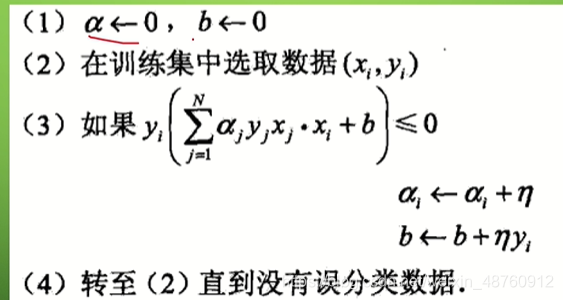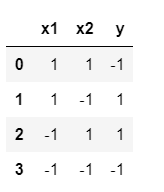-
感知机:判别模型、二分类线性模型
模型形式:
f ( x ) = s i g n ( w ⋅ x + b ) f(x)=sign(w\cdot x+b) f(x)=sign(w⋅x+b)
w w w和 b b b为感知机模型参数, s i g n sign sign是符号函数。 -
要求:数据集线性可分
-
目的:求将数据集线性划分为两部分的超平面
-
经验损失函数:所有误分类的点到超平面距离之和 L ( w , b ) L(w,b) L(w,b)
-
极小化经验损失函数方法:梯度下降法
-
算法流程:
- 输入:训练数据集 T = { ( x 1 , y 1 ) , ( x 2 , y 2 ) , ⋯ , ( x N , y N ) } T = \begin{Bmatrix} (x_{1},y_{1}),(x_{2},y_{2}),\cdots ,(x_{N},y_{N}) \end{Bmatrix} T={ (x1,y1),(x2,y2),⋯,(xN,yN)}, 学习率 η \eta η
- 输出:w、b以及感知机模型 f ( x ) = s i g n ( w ⋅ x + b ) f(x)=sign(w\cdot x+b) f(x)=sign(w⋅x+b)
- 第一步:初始化 w 0 w_{0} w0和 b 0 b_{0} b0
- 第二步:在训练集中选择数据 ( x i , y i (x_{i},y_{i} (xi,yi
- 第三步:如果 y i ( w ⋅ x i + b ) ≤ 0 y_{i}(w\cdot x_{i}+b)\leq 0 yi(w⋅xi+b)≤0:
w ← w + η y i x i w\leftarrow w+\eta y_{i}x_{i} w←w+ηyixi
b ← b + η y i b\leftarrow b+\eta y_{i} b←b+ηyi - 第四步:转至(2),直到没有误分类点。
-
算法对偶
这里每次更新的是误分类的次数 n i n_{i} ni,误分类会导致 n i n_{i} ni +1
同时,这里也会有个GRAM举证,是 x i ⋅ x j x_{i} \cdot x_{j} xi⋅xj形成的矩阵, x 11 = x 1 ⋅ x 1 x_{11} = x_{1} \cdot x_{1} x11=x1⋅x1, x 12 = x 1 ⋅ x 2 x_{12} = x_{1} \cdot x_{2} x12=x1⋅x2, x 13 = x 1 ⋅ x 3 x_{13} = x_{1} \cdot x_{3} x13=x1⋅x3
x 21 = x 2 ⋅ x 1 x_{21} = x_{2} \cdot x_{1} x21=x2⋅x1, x 22 = x 2 ⋅ x 2 x_{22} = x_{2} \cdot x_{2} x22=x2⋅x2, x 23 = x 2 ⋅ x 3 x_{23} = x_{2} \cdot x_{3} x23=x2⋅x3


参考b站的两个视频,对算法的推导理解比较好:
https://www.bilibili.com/video/BV1Pv411z7J4?from=search&seid=13315330278823399625
https://www.bilibili.com/video/BV14t4y1k7CM
对偶手动迭代可以看看:
https://www.cnblogs.com/qiu-hua/p/12755378.html
课后作业:
习题2.1
Minsky 与 Papert 指出:感知机因为是线性模型,所以不能表示复杂的函数,如异或 (XOR)。验证感知机为什么不能表示异或。
解答:
对于异或函数XOR,全部的输入与对应的输出如下:

%matplotlib inline
import matplotlib.pyplot as plt
import numpy as np
import pandas as pd
x1 = [1, 1, -1, -1]
x2 = [1, -1, 1, -1]
y = [-1, 1, 1, -1]
x1 = np.array(x1)
x2 = np.array(x2)
y = np.array(y)
data = np.c_[x1, x2, y]
data = pd.DataFrame(data, index=None, columns=['x1', 'x2', 'y'])
data.head()

positive = data.loc[data['y'] == 1]
negative = data.loc[data['y'] == -1]
plt.xlim(-2, 2)
plt.ylim(-2, 2)
plt.xticks([-2, -1, 0, 1, 2])
plt.yticks([-2, -1, 0, 1, 2])
plt.xlabel("x1")
plt.ylabel("x2")
plt.plot(positive['x1'], positive['x2'], "ro")
plt.plot(negative['x1'], negative['x2'], "gx")
plt.show()

显然感知机无法使用一条直线将两类样本划分,异或问题是线性不可分的。
习题2.2
模仿例题 2.1,构建从训练数据求解感知机模型的例子。
解答:
from sklearn.linear_model import Perceptron
import numpy as np
X_train = np.array([[3, 3], [4, 3], [1, 1]])
y = np.array([1, 1, -1])
perceptron_model = Perceptron()
perceptron_model.fit(X_train, y)
print("w:", perceptron_model.coef_, "\nb:", perceptron_model.intercept_, "\n")
result = perceptron_model.predict(X_train)
print(result)
